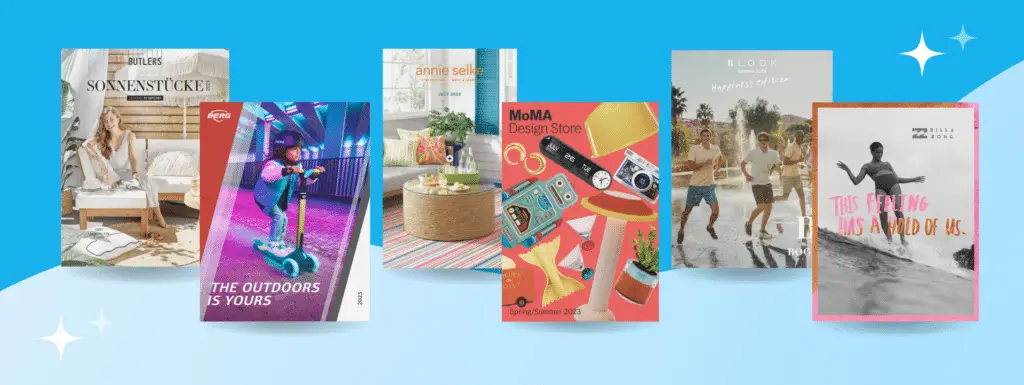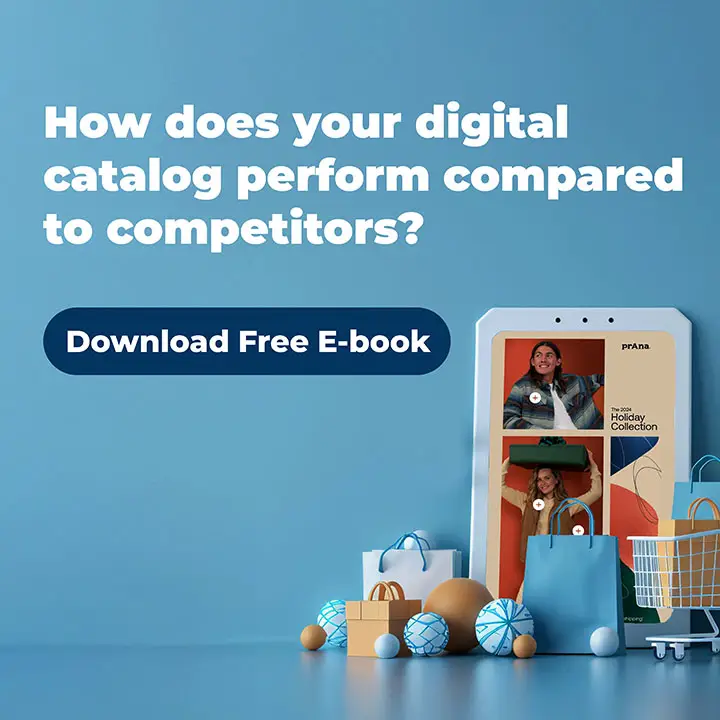With the rise of social media and e-commerce, the retail market has become increasingly competitive. These days, shoppers can browse and purchase products from retailers at the other end of the world in just a few clicks, making it much harder to maintain a strong customer relationship. One way to secure customer loyalty in this environment is through visual storytelling, and digital catalogs are a great tool to help you do so.
Read on as we share some of the best online digital catalog examples for 2025 that tell a beautiful brand story.
The Rise of Digital Catalogs
Part of what makes us human is the instinctual desire to express ourselves visually. Earliest examples of visual communication date back as far as 6 B.C. when our ancestors made hand stencils in caves by blowing pigment on their handheld to the wall.
![7 Inspiring Digital Catalog Examples in Retail [2025] 1 figures from the Egyptian times telling stories](https://www.publitas.com/wp-content/uploads/2017/02/history-of-storytelling.jpg)
Image from indiepenink.com
In the past, brands and marketers often trailed behind filmmakers and the media regarding visual storytelling. However, this is quickly changing, as marketing is shifting from merely interrupting people’s interests to actively creating content that captivates them.
It’s this shift toward visual storytelling that has also been responsible for the resurgence of brand catalogs in the last couple of years. Felix Carbullido, executive vice president and chief marketing officer for Williams-Sonoma, said they are still committed to digital catalogs but that their view of them has changed:
“Years ago it was a selling tool, and now it’s become an inspirational source.”
They added a pop-up survey to their website and discovered that 75% of their converting customers first browsed their digital catalog.
Where are online retail catalogs now?
Online catalogs have become very popular. There is evidence that in today’s shopping landscape, consumers increasingly conduct product research online. Gone are the days of relying on printed catalogs to be delivered to customers’ homes; instead, engaging them on the appropriate communication channels is essential. Rather than visiting physical showrooms, customers now seek convenient online access to your complete product range. Embracing digital catalogs becomes the solution, allowing your brand to resonate with prospective online shoppers.
Unlike printed catalogs, measuring the impact of digital catalogs online is much more manageable, and data tracking offers a valuable means of reporting on their effectiveness. By monitoring metrics such as open rates, time spent on specific pages, and elements clicked, qualitative data provides insights into catalog performance with every online distribution. Analyzing this data enables you to make targeted changes, ensuring your catalogs align with evolving retail expectations. This approach empowers you to keep pace with changing consumer preferences while effectively utilizing the advantages offered by digital tools.
With this in mind, we looked through hundreds of digital retail catalogs recently published by our customers. We took some of the best online catalog examples that use visual storytelling to inspire shoppers.
Digital Catalog Examples
1. Billabong’s Online Catalog
![7 Inspiring Digital Catalog Examples in Retail [2025] 2 Five teenagers walk along a beach with surfboards in billabong clothes](https://www.publitas.com/wp-content/uploads/2017/02/Billabong-catalog-page-1024x591.png)
What we love about this catalog:
-
- Their tagline “a bikini kinda life,” which refers to the beach, the summer, and the surf lifestyle that their brand is about.
-
- Thoughtful copy paired with beautiful images captures the emotions that go with their products. For example, the image on pages 22-23 — the scene evokes memories of summer and, paired with a foreign caption, makes the reader feel they are viewing the product in an exotic location they could be in.
-
- While there is a heavy focus on beautiful images and inspiration, Billabong has ensured shoppers can easily buy products when they want to. Links in the catalog make it easy to transition from the catalog to the matching product in Billabong’s online store.
2. Museum of Modern Art‘s Digital Catalog
![7 Inspiring Digital Catalog Examples in Retail [2025] 3 home decor images with a chair and lamp](https://www.publitas.com/wp-content/uploads/2017/02/MoMA-catalog-video-thumbnail-1-1024x718.png)
What we love about this catalog:
-
- Their retail catalog has a colorful page filled with fun and summery items. The introduction paragraph, “Unexpected Discoveries,” sets the mood for the catalog’s viewers so they will experience it as a magical show. That’s a great way to connect with shoppers.
-
- MoMA uses interactive elements such as GIFs to encourage engagement from viewers
-
- Besides showcasing their collection, the catalog contains content aimed at connecting to the audience and selling a promise. A few examples in this catalog that stand out are Dining and Entertaining pages that mention: “Gather and spark conversations with fresh designs for spring.”, Kids on the go section promises easier travel time when traveling with kids. Who wouldn’t want that?
3. Boggi’s Digital Catalog
![7 Inspiring Digital Catalog Examples in Retail [2025] 4 Adults playing in water wearing Boggi clothing](https://www.publitas.com/wp-content/uploads/2017/02/Boggi-catalog-example-1024x646.png)
What we love about this catalog:
-
- This digital catalog is dedicated to elegant and casual man’s clothing.
-
- Boggi uses scene pictures rather than small product images. It focuses on selling a story and an experience, allowing the shoppers to easily imagine what it could be like wearing the Boggi collection.
-
- We love the tagline: “Happiness is a journey.”
4. Annie Selke’s Online Catalog
![7 Inspiring Digital Catalog Examples in Retail [2025] 5 Catalog pages with bed and linen samples](https://www.publitas.com/wp-content/uploads/2017/02/Annie-Selke-Catalog-1024x731.png)
What we love about this catalog:
-
- In the introduction to their retail catalog, Annie Selke explains the philosophy behind the brand: “Since day one, it’s been essential to us as a company that we make the world a better place while also helping you create a beautiful home.”
-
- Different sections inside this online catalog lay the focus on “durable, eco-friendly and hand-made” products in line with the company’s philosophy and vision.
-
- Their catalog mostly contains beautiful images that serve to inspire. However, when clicking on those images, further product details are presented in a product overlay. This way, shoppers can easily purchase the product when they are interested.
5. So iLL’s Retail Catalog
![7 Inspiring Digital Catalog Examples in Retail [2025] 6 Jason Momoa is holding a so ill shoe](https://www.publitas.com/wp-content/uploads/2017/02/So-iLL-catalog-1024x554.png)
What we love about this catalog:
-
- On page 3&4 of their online catalog, So iLL explains their mission and vision. This way, it’s immediately established what to expect from their catalog.
-
- The combination of large product photos with simple descriptions, as well as photos that show climbers in action, creates a context to get a better understanding of what their brand is about.
-
- By inviting the shoppers to learn more about the brand and history in the documentary, they create a sense of community that might make a shopper feel more connected to the brand.
-
- Lastly, who doesn’t love Jason Momoa?!
6. American Girl’s Online Catalog
![7 Inspiring Digital Catalog Examples in Retail [2025] 7 American girl dolls dressed up as harry potter characters](https://www.publitas.com/wp-content/uploads/2017/02/American-Girl-catalog-showing-harry-potter-collection-1024x615.png)
What we love about this catalog:
-
- Each page is a different scene and story creating some great imaginative play for any child viewing the toy collection, such as the Harry Potter example above.
-
- Parents and children can get a feeling for how they might set up their American Dolls to play.
-
- Using QR codes throughout the online catalog allows the parent to allow their children to experience the toy collection further in more detail.
-
- We love how diverse the doll collection is – there is a representation of all cultures enabling children to be able to relate throughout the catalog experience.
7. Butlers’s Digital Catalog
![7 Inspiring Digital Catalog Examples in Retail [2025] 8 BUTLERS catalog cover showcasing a smiling woman dressed in light clothing, sitting on a garden sofa enjoying a drink](https://www.publitas.com/wp-content/uploads/2023/03/butlers-catalog-cover-summer-2023-787x1024.jpg)
What we love about this catalog:
-
- The overall summer theme gives their retail catalog a happy, warm vibe giving shoppers inspiration for their own summer-themed home decor setups
-
- The creative photography style shows real-life setups using BUTLERS products. It’s very inspiring for the shoppers!
-
- The use of models in the pictures (especially the furry ones!) – the set-ups become more relatable, and viewers get emotionally invested.
We hope this handful of digital catalog examples has shown how you can focus on telling brand’s story to entice, inspire and connect to your audience, building a stronger relationship that ultimately leads to increased sales.


